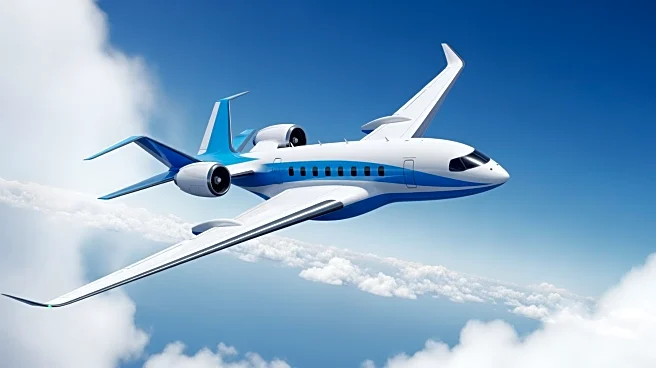What's Happening?
Outbound Aerospace is pioneering a new era in aviation with its blended-wing aircraft concept. In March 2025, the company successfully launched a small V-shaped remote-controlled aircraft, codenamed Steve, from the Pendleton UAS Range in Oregon. This
unmanned vehicle, although it flew for only 16 seconds, represents the initial step towards developing a 200 to 250-seat blended-wing airliner, named the Olympic, expected to debut in the 2030s. The blended-wing design, which integrates the fuselage and wings into a single structure, aims to enhance aerodynamic efficiency. This concept, while not new, has primarily been explored by the US military for bombers. Outbound Aerospace's initiative is driven by the aviation industry's urgent need to reduce emissions, positioning the company at the forefront of potentially transformative changes in commercial air travel.
Why It's Important?
The development of blended-wing aircraft by Outbound Aerospace could significantly impact the aviation industry by offering a more aerodynamically efficient design, potentially leading to reduced fuel consumption and lower emissions. This innovation aligns with global efforts to address climate change by minimizing the carbon footprint of air travel. If successful, the Olympic airliner could set a new standard for commercial aircraft, influencing major airlines and manufacturers to adopt similar technologies. The shift towards more sustainable aviation solutions could also stimulate economic growth within the aerospace sector, creating new opportunities for startups and established companies alike. However, the transition to blended-wing designs will require overcoming technical challenges and gaining regulatory approvals, which could shape the future landscape of air travel.
What's Next?
Outbound Aerospace will likely continue testing and refining its blended-wing technology to address the technical challenges associated with this design. The company will need to secure funding and partnerships to advance the Olympic airliner from concept to reality. Regulatory bodies will play a crucial role in certifying the new aircraft design, ensuring it meets safety and performance standards. As the project progresses, major stakeholders in the aviation industry, including airlines and manufacturers, will be closely monitoring developments. The success of this initiative could prompt increased investment in similar technologies, potentially leading to a broader adoption of blended-wing aircraft in commercial aviation.
Beyond the Headlines
The introduction of blended-wing aircraft could have far-reaching implications beyond environmental benefits. It may influence the design and construction of future airports, as these aircraft could require different infrastructure due to their unique shape. Additionally, the shift towards more sustainable aviation technologies could drive policy changes and encourage further research into alternative fuels and propulsion systems. The cultural perception of air travel might also evolve, with passengers becoming more conscious of the environmental impact of their flights and preferring airlines that adopt greener technologies.















